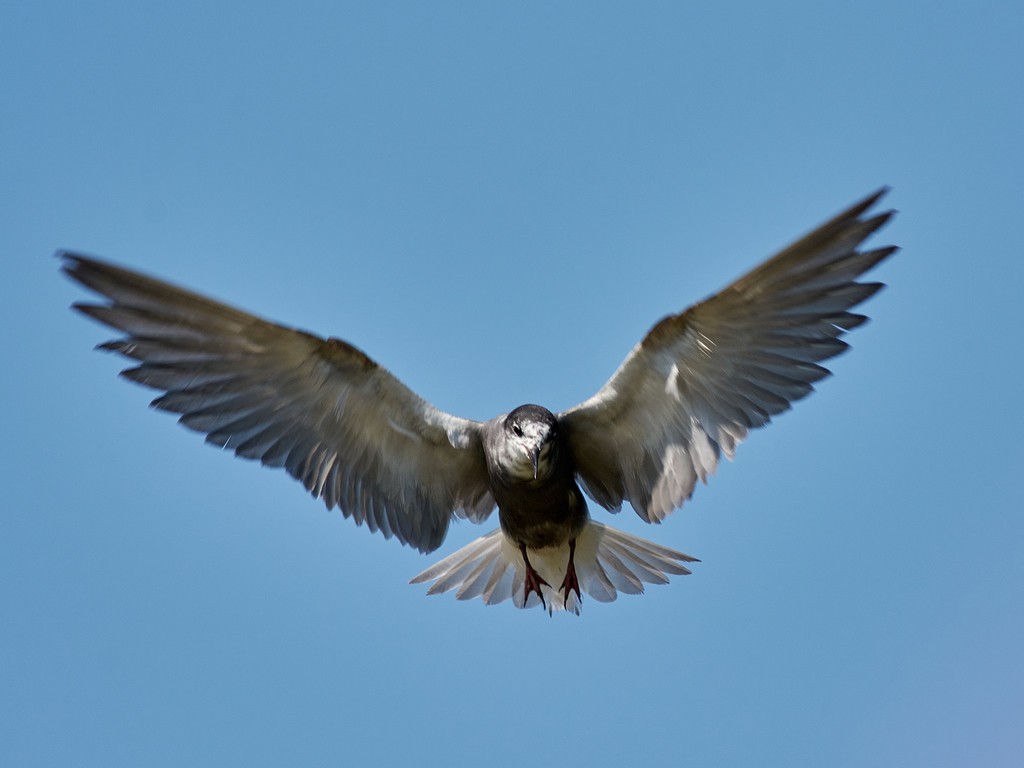Black Tern
A species of Marsh terns Scientific name : Chlidonias niger Genus : Marsh terns
Black Tern, A species of Marsh terns
Botanical name: Chlidonias niger
Genus: Marsh terns
Content
Description People often ask General Info
Description
Adults are 25 cm (9.8 in) long, with a wingspan 61 cm (24 in), and weigh 62 g (2.2 oz). They have short dark legs and a short, weak-looking black bill, measuring 27 mm (1.1 in), nearly as long as the head. The bill is long, slender, and looks slightly decurved. They have a dark grey back, with a white forewing, black head, neck (occasionally suffused with grey in the adult) and belly, black or blackish-brown cap (which unites in color with the ear coverts, forming an almost complete hood), and a light brownish-grey, 'square' tail. The face is white. There is a big dark triangular patch in front of the eye, and a broadish white collar in juveniles. There are greyish-brown smudges on the ides of the white breast, a downwards extension of the plumage of the upperparts. These marks vary in size and are not conspicuous. In non-breeding plumage, most of the black, apart from the cap, is replaced by grey. The plumage of the upperparts is drab, with pale feather-edgings. The rump is brownish-grey. The North American race, C. n. surinamensis, is distinguishable from the European form in all plumages, and is considered by some to be a separate species. In flight, the build appears slim. The wing-beats are full and dynamic, and flight is often erratic as it dives to the surface for food; similar to other tern species. Its call has been described as a high-pitched "kik"; the sound of a large flock has been called "deafening". 
Size
23-25 cm (9-10 in)
Colors
Black
Gray
White
Life Expectancy
17 years
Nest Placement
Floating
Incubation Period
1 brood
Number of Broods
19 - 21 days
Nestling Period
18 - 24 days
Feeding Habits
Black Tern's diet primarily consists of small fish and insects. They hunt by flying over water or marshland, snatching prey without deep diving, and pursuing airborne insects with agility. Their diet includes grasshoppers, locusts, flies, and on occasion, forages over fields. They primarily consume small fish like anchovies and sardines during the nonbreeding season.
Habitat
Black Tern primarily frequents freshwater marshes with dense vegetation and is adaptable to various climates, from temperate to tropical zones. The species occupies habitats near shallow lakes in northern forests and open prairies, often nesting on floating materials. Its distribution includes North America, Europe, and western Asia. During nonbreeding seasons, black Tern can be found in tropical oceanic waters, coastlines, estuaries, and even altered landscapes like shrimp farms.
Nest Behavior
Both sexes of black Tern participate in selecting the nest site and arranging dead vegetation to form the nest. Nest building coincides with the availability of suitable floating vegetation. Egg-laying patterns and parental roles in incubation and chick rearing are shared responsibilities between the male and female black Tern.
Nest Characteristics
Black Tern constructs its nest in shallow, still water areas, well away from shore and half-covered in emergent vegetation like cattails and bulrushes. It utilizes dead, floating vegetation or muskrat platforms to support the shallow mound nest, measuring approximately 6.9 inches wide and 1.6 inches tall, with a 3.5-inch inner cup.
Dite type
Insectivorous
People often ask
General Info
Feeding Habits
Bird food type
Sounds
Call
Recording location: Netherlands
Behavior
Black Tern display a rich tapestry of social interactions, particularly noticeable during breeding season with their elaborate courtship rituals. These involve high-altitude group flights, characterized by acrobatic swoops and vocal excitement, occasionally with large numbers of participants. Once paired, they exhibit courtship feeding where males present prey to their mates in a nuanced exchange. Black Tern's monogamous nature is overshadowed by their independence as they nest loosely, with pairs vigilantly maintaining a buffer around their nests. Post-hatching, parental guidance extends to nocturnal migrations, with juveniles staying in wintering zones for a full year. In contrast, the nonbreeding season witnesses highly gregarious black Tern flocks, mingling with other seabirds and resting on floating debris, showcasing their adaptability to their environment.
Distribution Area
Their breeding habitat is freshwater marshes across most of Canada, the northern United States and much of Europe and western Asia. They usually nest either on floating material in a marsh or on the ground very close to water, laying 2–4 eggs. In England the black tern was abundant in the eastern fens, especially in Lincolnshire and Cambridgeshire, until the early nineteenth century. The English naturalist Thomas Pennant in 1769 referred to "vast flocks" of black terns "whose calls are almost deafening." Extensive drainage of its breeding grounds wiped out the English population by about 1840. Intermittent attempts by the black tern to recolonise England have proved unsuccessful, with only a handful of English breeding records, and one in Ireland, in the second half of the twentieth century. North American black terns migrate to the coasts of northern South America, some to the open ocean. Old World birds winter in Africa. Unlike the "white" Sterna terns, these birds do not dive for fish, but forage on the wing picking up items at or near the water's surface or catching insects in flight. They mainly eat insects and fish as well as amphibians. 
Species Status
The North American population has declined in recent times due to loss of habitat. The black tern is one of the species to which the Agreement on the Conservation of African-Eurasian Migratory Waterbirds (AEWA) applies. 
